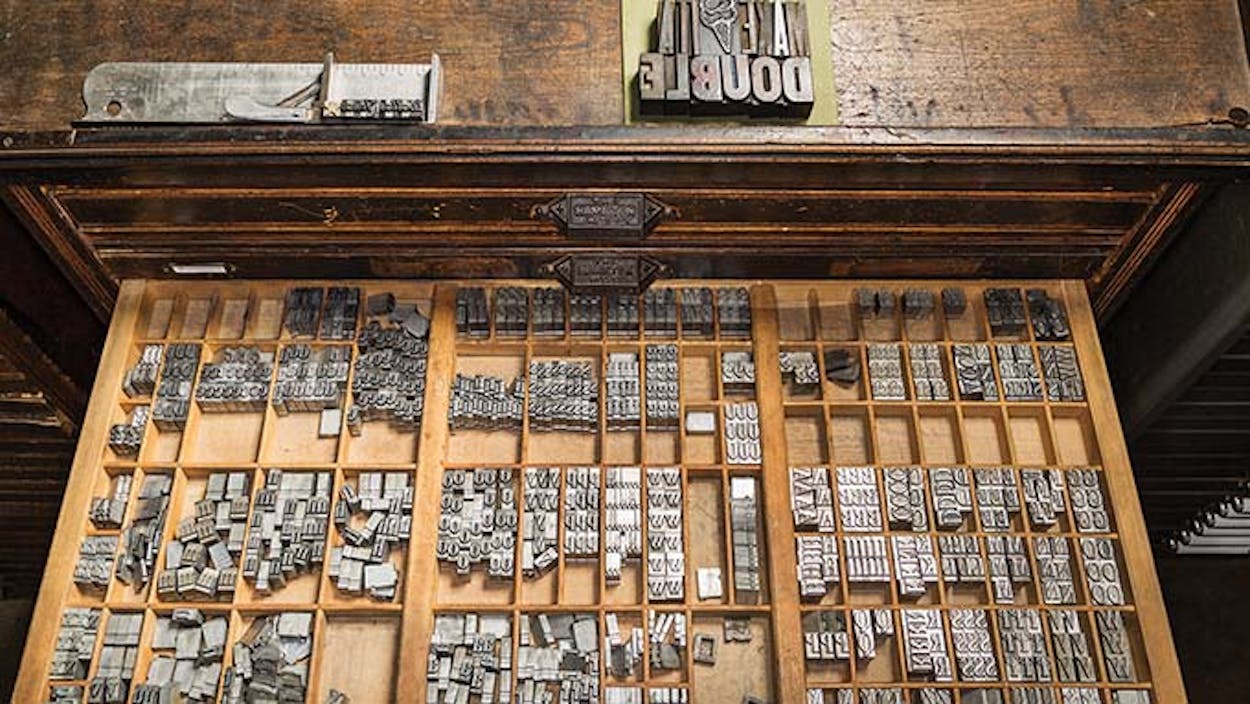One of the many posters hanging in the Deep Ellum studio of Elefant Press says it all: “Art Is Work.” The quote—from famed graphic designer Milton Glaser—rings especially true as Fernando Gonzalez moves about his shop, hand-cranking the Vandercook printing press again and again or mixing ink to get the perfect Pantone shade. Gonzalez, a former ad-agency art director, got his start in letterpress printing in 2010, with a small tabletop press in his apartment. Today, the 34-year-old has expanded to three presses in an 1,100-square-foot industrial space. His business is largely devoted to printing other people’s designs, usually in the form of wedding invitations (he produced invites for more than three hundred happy couples last year); he and his assistant, Caleb Rose, also do their own creative work—posters, cards—on the side.
Gonzalez, who studied computer science at Baylor before majoring in graphic design at Boise State, appreciates letterpress for its tactile, non-computerized look and feel. “The process gives you something that can’t be replicated digitally,” he says. “The ink sits on the paper. The unique textures from the eccentricities of worn one-hundred-year-old type give a print character. It feels luxurious and can really elevate a design. It’s not a bunch of pixels overlapping.”
Q&A with Fernando Gonzalez
What is the difference between letterpress printing and other forms of printing, like offset silk-screen, and digital?
Letterpress printing is a relief printing process. A raised image is made in reverse and inked, then paper is placed over the image and pressure is applied, resulting in a print. The raised image can be a carved piece of wood or linoleum, moveable type, or printing plates made from metal or hard plastic. Each color requires a unique plate.
Which plates do you like to use?
If I am printing business cards or invitations from someone else’s design, made on the computer, I use photopolymer plates, made of light-sensitive plastic. I currently use a company out of New York State called Boxcar Press for printing plates. But I also create my own designs using handset type or woodcuts. I love chromatic wood type, which has two designs for each character, and when you print them together using two different colors, they overlap and produce a third color, so you get vivid three-color type.
What are some of the challenges of letterpress?
It’s a slow, tedious process. You can’t just press a button on your computer and have a letterpress print come out. You have to register the plate, makeready the print, run the job, and then repeat the process for each color. Since you’re printing each color separately, if the registration is off by even a point, it’s noticeable. If something is not printed perfectly square on the paper, once it’s cut, it will be noticeable. Also, each piece needs to be printed in exactly the same place so it will be cut uniformly. So a lot of effort goes into setting up each job. You don’t want to spend hours printing a job only to have it look crooked.
What is your favorite part of the whole process?
Mixing ink by hand. I use the Pantone system, which has a bunch of base colors and a formula guide to match specific colors. I used to weigh out each part of the mix, but I’ve become really good at just eyeballing it now.
How did you decide on the name Elefant Press?
A few reasons. I remember a collection of elephant figurines my grandmother had when I was younger, so it reminds me of her warmth. Also, one of my first printing presses, the Vandercook old-style 219-proof press, is a massive gray cast-iron beast of a machine with a crank that looks like an elephant’s trunk. And then the phonetic spelling, with an f, is because it’s somewhere in between Spanish and English, just like me.
For more information, go to elefantpress.com.
- More About:
- Business







